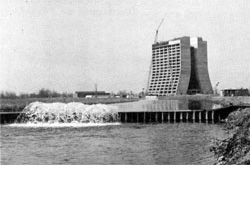From Archimedes to Evanescence - NAL's Water Supply


Another new structure rose on the NAL landscape, across Wilson Road from the Bubble Chamber. A textured concrete wall in the shape of an Archimedes Spiral providing an enclosure and an accessway for the pumping station at Casey's Pond, the main reservoir on site. The temporary pumps which operated there in early 1973 were removed when the station was completed.
This intriguing structure was just one part of the complex system which keeps NAL supplied with water. Water plays a very important role in the operation of the site. It is used for cooling the magnets in the accelerator system, for industrial purposes, for fire protection, for a very limited amount of irrigation, and, of course, for domestic consumption.
Originally, this portion of Illinois was a wet prairie, with clumps of trees on the high ground. During the years it was used as farmland, the prairie was drained primarily by the use of underground tile. When NAL first came to Batavia, much thought was given to the problem of providing sufficient water on site, so as not to tax the resources of the surrounding communities. The solution was the creation of large water storage reservoirs and cooling ponds.
As a result, there are now four reservoirs - Lake John Law and Lake Ephemeral, which collect water from the eastern portion of the site; the Sea of Evanescence, which collects water from the southeastern portion of the site; and Casey's Pond, the main reservoir in the north-western portion of the site. The names Ephemeral (from the Greek, meaning short-lived, transitory) and Evanescence (also from the Greek, meaning gradually fading away) result from the fact that the Lakes were created by dams and they will vary in size, and perhaps at times, completely disappear during very dry years. Casey's Pond is named for K.C. Brooks, the AEC Area Manager who contributed so greatly to the success of the Project. John Law was a Scottish monetary reformer, who founded a French bank in 1715. He later merged it with the Louisiana Company, which had exclusive rights to the development of the French territories in the Mississippi Valley, which included the NAL site. The development scheme, the "Mississippi Bubble" failed, and Law died in Venice, a poor, but honest man. In all of these reservoirs, NAL has the capacity to store 140 million gallons of water, according to former Plant Manager Bill Riches.
In addition to these reservoirs, there are twenty-five ponds which form a canal around the inside of the Main Ring. The water in these ponds was used for cooling the accelerator system - perhaps the most important use of water on site. According to Hank Hinterberger, of Technical Services, NAL used a combination of air and water cooling in the system - the Linac, Booster and Main Ring were cooled by water; cooling for apparatus in the three experimental areas was provided, for the most part, by air coolers along the beam lines. Hinterberger and George Biallas were responsible for designing much of the system.
The electromagnets in the accelerator, which get hot from the electrical current used to energize the electric fields, were cooled by an independent system of low-conductivity water (from which nearly all of the mineral content has been removed in a de-ionizing tank, or giant water softener, in the B-0 service building). This water, de-ionized to prevent the magnets from shorting, circulated through them in the same copper tubing which carried the electrical current and then was cooled as it passed through heat exchangers in each service building. Ordinary water from the cooling ponds circulated through the heat exchangers and then, in turn, was cooled by evaporation when it returnd to the ponds. Make-up water was supplied by the reservoirs. The Booster Pond was used for cooling the Linac and Booster, as well as equipment in the Central Utilities Building nearby.
The primary source of water on site is rainfall, which is collected in all four of the reservoirs. In an average year - one in which there about 34 inches of precipitation - this is enough to supply all of the industrial water needs on site. In a below average year, the Laboratory could draw water from the Fox River via the pipeline from Batavia to Casey's Pond (so long as the river flows at an excess of 275 cubic feet per second). As yet, NAL has not used this pipeline. Another pipeline, actually an old gas line which passes under both Kress Creek and Lake John Law, was connected so water from the creek could be pumped directly into that reservoir. This line was used once, in 1971.
All of the water for domestic use is supplied by three shallow wells, one in the Village and two at the main site. Each is about 200 feet deep. Another, very deep - about 1600 feet-well, has never been used. It would be required only in the case of an emergency, for example, as an adjunct to the fire-fighting water supply.
A new pond was constructed in 1973 in the center of the Main Ring. It was in the shape of the NAL logo. Neither it nor the reflecting pool near the Central Laboratory are part of the inter-connected water system.
The operation and maintenance of this far-flung system was the responsibility of the men of Plant Maintenance and Operations, under the supervision of Bob Vanacek, Jack Morphey, and Bob Roberts. George Doyle and Jack Stahl, of Plant Services, were primarily responsible for the installation and operation of the temporary pumps at Casey's Pond; the men of Plant Services were responsible for the reservoirs on the eastern portion of the site. All in all, they kept approximately 25 miles of underground piping and more than 100 pumps connected to the system operating smoothly.



